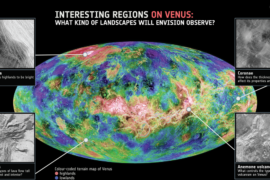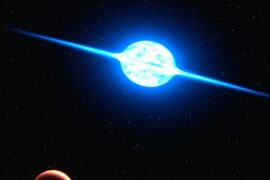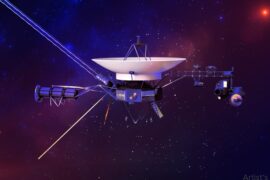The Moon and Pluto are two bodies that even though they belong in different categories – one is a dwarf planet and one is a satellite – are often compared because they share some similarities. For example, they are similarly sized and their atmospheres are very thin.
In this article, we’ll compare the Moon vs Pluto and analyze their differences and similarities.
Let’s start by comparing the raw numbers of their physical characteristics.
Moon vs Pluto comparison chart
| Moon | Pluto | |
|---|---|---|
| Type | Natural satellite | Dwarf planet |
| Location | Earth’s orbit | Kuiper Belt |
| Distance from the Sun (avg) | 150 million km | 5.9 billion km |
| Radius | 1,737 km | 1,188 km |
| Mass | 7.342×1022 kg | 1.303×1022 kg |
| Rotation period (1 day) | 29.5 days (tidal locked) | 6.4 days |
| Orbital period | 29.5 days (around Earth) | 247.94 years (around the Sun) |
| Orbital speed | 1.022 km/s | 4.74 km/s |
| Surface temperature (avg) | -183°C (night) / 224°C (day) | −240 °C |
| Surface pressure | almost zero (< 0.3 nPa) | 1 Pa |
| Surface gravity | 1.62 m/s2 | 0.6 m/s2 |
| Density | 3.34 g/cm3 | 1.86 g/cm3 |
| Escape Velocity | 2.38 km/s | 1.21 km/s |
| Albedo | 0.136 | 0.52 |
| Satellites (Moons) | 0 | 5 |
| Core | iron | silicate |
| Atmosphere | Argon, helium, neon | Nitrogen, methane, carbon dioxide |
Mercury vs Venus Size Comparison
The following image shows the size comparison between Pluto and the Moon.
Pluto is about 68% the size of the Moon. In the ranking of the largest objects in the Solar system, the Moon is at number 14 while Pluto is at 17.
For comparison, the Moon is approximately 27% the size of the Earth and Pluto is about 18.6%.
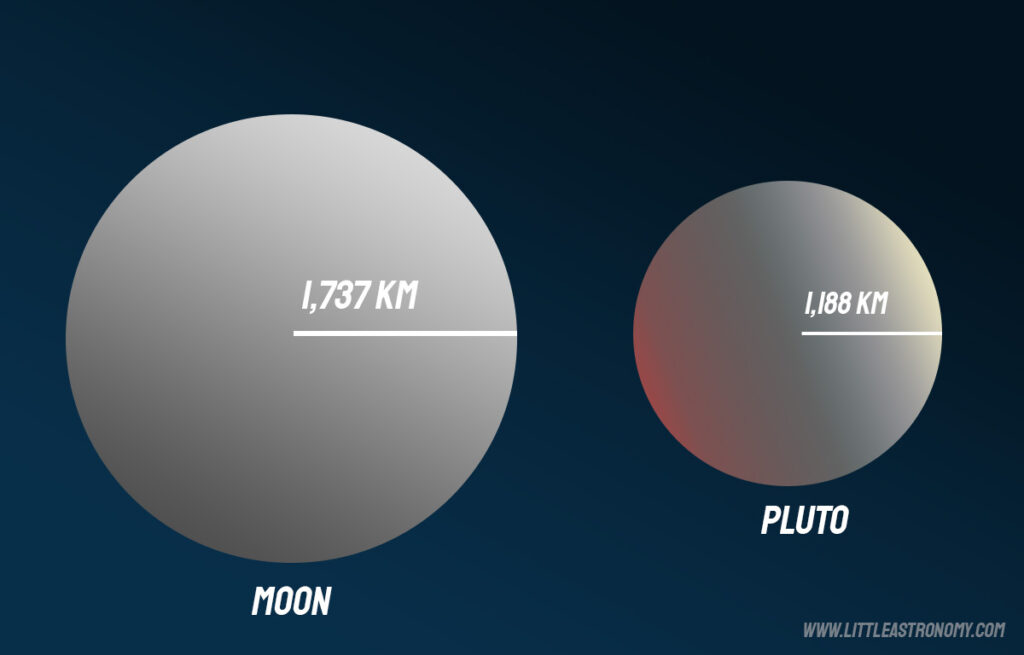
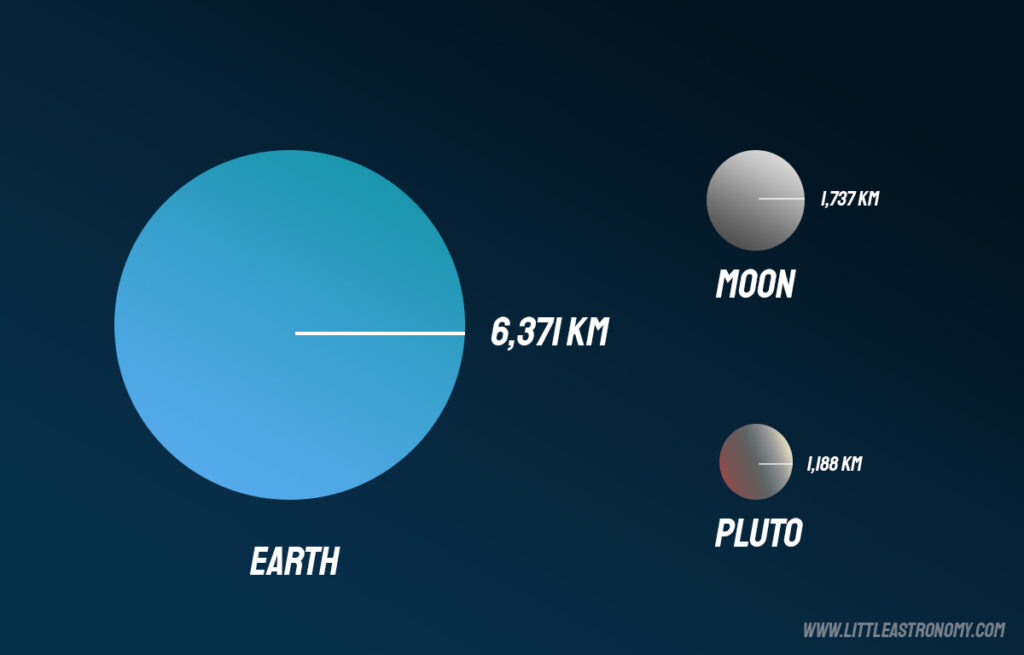
Moon vs Pluto Differences
- The Moon is a natural satellite. Pluto is a dwarf planet.
- The Moon orbits a planet (Earth). Pluto orbits the Sun.
- Pluto has its own natural satellites. The Moon doesn’t.
- The Moon is almost one-third bigger than Pluto.
- Pluto rotates almost sideways. The Moon is tidally locked, which means it doesn’t rotate in relation to Earth.
- Pluto’s surface has regions with varied colors like red and yellow. The moon’s surface has mostly uniform grey tones.
- The Moon’s atmosphere is mostly made out of argon, neon, and helium and lacks neutral species (oxygen, nitrogen, hydrogen, carbon). Pluto’s atmosphere does contain those nitrogen, CO2, and methane.
- Pluto has an icy crust below its thin surface. The Moon only has ice in certain regions of its surface, like the poles.
- Pluto is theorized to have a subsurface ocean of liquid water below its ice layer. The Moon is unlikely to have any liquid water.
- Pluto has multiple layers before getting to its core. The Moon only has a uniform mantle below its core.
- The Moon’s core is made out of iron, both molten and solid. Pluto’s core is made of silicate.
- Pluto’s core is larger than the Moon’s, despite being smaller as a whole.
- Pluto’s orbit is much more eccentric (elliptical) than the Moon’s orbit.
- The Moon orbits a planet while Pluto orbits a star.
Moon vs Pluto Similarities
- Both objects have a similar age. They formed approximately 4.6 billion years ago.
- They both have very thin atmospheres with low density.
- They are both believed to have pockets of temperature where liquid water could exist.
- The Moon doesn’t have a magnetic field and while it hasn’t been confirmed whether or not Pluto has one, it is believed that due to its size, it doesn’t have one either.
- Neither of them is a good candidate in the search for extraterrestrial life.
- Both have enough mass for their gravity to give them their round shape.
- If the Moon was a dwarf planet, it would have enough mass to maybe capture its own moons, just like Pluto does.
- They both have solid, rocky surfaces that humans can walk on (with the help of a spacesuit).
- They are both tidally locked to another object. The Moon to Earth, and Pluto to its moon, Charon. This means that from the surface of the other object you would only see one side of the tidally locked object, just like we see only one side of the Moon from Earth.
- Neither has rings surrounding them.
Summary
- Pluto and the Moon are different types of celestial objects but they have some things in common.
- Some similarities between the Moon and Pluto are the lack of magnetic field, thin atmospheres, and rocky surfaces.
- The differences between Pluto and the Moon include their size, rotation, composition, and colors.
Enjoyed this article?
Get daily 10-minute PDFs about astronomy to read before bed!
Sign up for our upcoming micro-learning service where you will learn something new about space and beyond every day while winding down.




